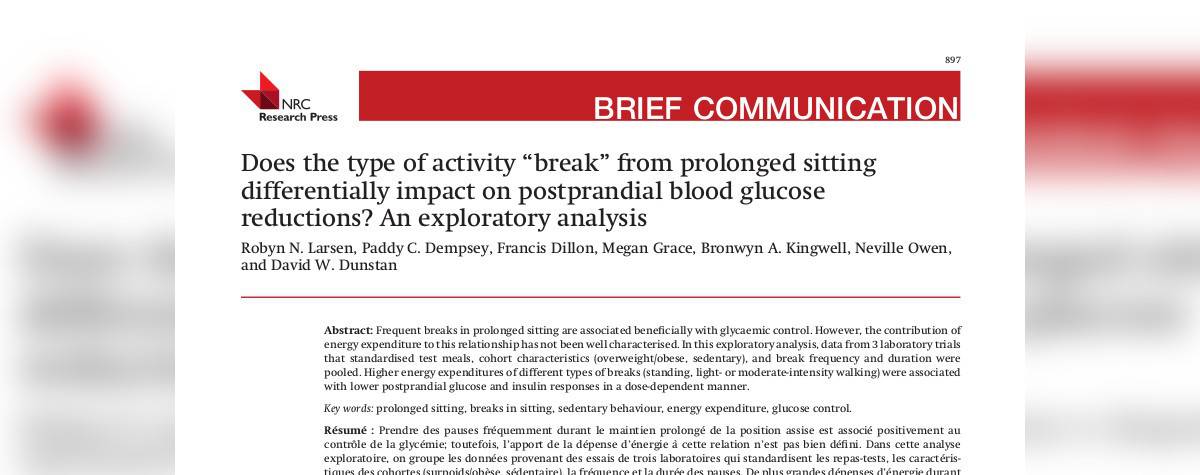
Breaks from sitting can improve post-meal glucose and insulin: is the type of break important?
September 13, 2017
October Issue of WellSpring Features SBRN Terminology Consensus Project
October 3, 2017Travis’ Note: Today’s post comes from Dr Allana LeBlanc. You can find more on Allana at the bottom of this post. If you’re not familiar with current definitions for sedentary time, or screen time, have a look at the consensus project by the Sedentary Behaviour Research Network here.
Sedentary behavior (especially screen time) has been compared to everything from cigarettes to serial killers and in the world of health fads, it’s safe to say that reducing sedentary time has earned a spot at the cool kids table.
In recent years, research on sedentary behavior has grown exponentially. To be fair, all research has grown exponentially, but research on sedentary behavior only really started in the 1950s, and is now a distinct field of study. Since then, the research landscape has been flooded by new and evolving screen-based devices that have both made our lives easier, and increased our risk for numerous chronic diseases. In a narrative review for the Translational Journal of the American College of Sports Medicine, we looked at the evolution of screen-based technology and how it has affected our health (and yes, we even included some benefits!).

Publications related to sedentary behaviour/screen time, by year. From LeBlanc et al. 2017 (Translational Journal of the American College of Sports Medicine).
Admittedly, this was a narrative, not a systematic review, so we may have missed some studies, but, this also let us explore a wide range of topics, including a brief historical overview. Like did you know that efforts to build the first television started as far back as 1873? That the first iPhone was released in 2007, and by 2015, 68% of adults in the U.S. owned a smartphone? We sometimes forget that the World Wide Web was introduced in 1989 and there is now a whole generation that have never lived without it. Being connected is literally part of who they are.
This history helps us understand why there are so many discrepancies and unknowns in the current research. Technology is moving at such a rapid rate that we are having a hard time keeping up. By the time we examine a relationship (of a certain device, in a certain population, on a particular outcome), things have changed. And I mean literally part of the equation is obsolete (anyone holding a flip-phone!?).
Despite these limitations, there are trends. Limiting screen time in children to <2 hours per day has been associated with better measures of body composition, improved fitness, better self-esteem and self-worth, pro-social behavior, and better academic achievement. In adults, high levels of screen time increase risk for premature-all cause mortality (no matter how active you are). High levels of screen time have also been linked to cardiovascular disease, type 2 diabetes, and metabolic syndrome.
But you promised benefits?! It’s true, many reviews gloss over the fact that there are benefits of screen time (and not just anecdotal reports that there’s a new app that’s “life changing”). Technology is at a point where users are not just observers, but part of the experience. Playing video games can actually change the way we process information, can improve attention, special processing, problem solving, and creativity. Educational TV programming can also help broaden children’s knowledge by exposing them to difference races, sexual orientations, and ways of life. Backed by a recommendation from the American Academy of Pediatrics, the internet can increase social support and connection, and civic engagement. And of course social media, despite many limitations, can bring people together from all corners of the world. Of course, we can’t forget augmented reality games like Pokémon GO. Which despite its short half-life, was able to engage the hard-to-reach, high-risk segment of the population.
Clear as mud? Perfect. Good news is that there is a lot more to be done, and since technology (and screens) seems to be ingrained in our day-to-day lives, scientists, health care providers, and policy makers will be able to keep themselves busy for the foreseeable future.

About the Author: Allana LeBlanc is a Post Doctoral Fellow in the Division of Prevention and Rehabilitation at the University of Ottawa Heart Institute.You can follow her on Twitter @AllanaLeBlanc.




